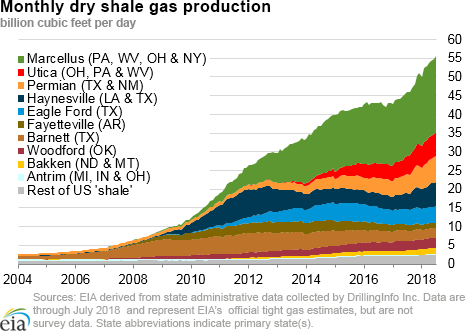In the News:
Government of Trinidad and Tobago secures additional upstream supply for the Atlantic LNG project
Last month, the government of Trinidad and Tobago signed an agreement with Venezuela to purchase 0.15 billion cubic feet per day (Bcf/d) of natural gas from Venezuela’s offshore Dragon field, providing much needed additional feedstock for the Atlantic liquefied natural gas (ALNG) project. LNG production from ALNG, located in Point Fortin, Trinidad, has decreased in recent years as a result of upstream natural gas feedstock shortages. The maturing offshore fields that supply the project are in decline, which has led to reduced LNG output from the ALNG facility.
In recent years, ALNG project stakeholders have identified several new fields to shore up LNG production. In 2017, BP started production from the Juniper field, which will supply 0.59 billion cubic feet per day (Bcf/d), and also sanctioned the development of the Angelin field (0.6 Bcf/d), expected to start production in 2019. BP has also commissioned the Trinidad onshore compression project (0.2 Bcf/d) to increase feedstock supply to the facility. Additional offshore fields that could provide natural gas feedstock for the project were also discovered, including BHP Billiton’s LeClerc field containing 4 trillion cubic feet (Tcf)–5 Tcf of reserves and BP’s blocks near Juniper and Cashima fields containing 2 Tcf of reserves.
ALNG has four liquefaction units (called trains) in operation, with a combined capacity of 2 Bcf/d. ALNG began LNG production in 1999 and was the first LNG facility built in the Atlantic Basin. Project stakeholders considered further expansion of the facility in 2005–07 by adding Train X, but were unable to identify a sufficiently large natural gas resource base to supply the new train. Since 2014, the facility has experienced the declining use of its capacity, which in 2016 reached an all-time low of 1.46 Bcf/d, implying facility utilization of only 73% compared to 103% in 2010.
Most of ALNG’s exports are shipped to South America, Europe, and the United States. Declining demand in Argentina, Brazil, and Europe post-2014 coincided with an overall decline in ALNG output in this period. ALNG exports to the United States are shipped primarily to Everett import terminal near Boston, Massachusetts, and serve as an important supply source to meet seasonal winter peak demand in New England. In 2017, U.S. LNG imports from Trinidad accounted for 96% of total U.S. LNG imports, of which 91% (0.18 Bcf/d) went to Everett terminal.
Overview:
(For the Week Ending Wednesday, September 5, 2018)
- Natural gas spot price movements were mixed this report week (Wednesday, August 29 to Wednesday, September 5). Henry Hub spot prices fell from $2.96 per million British thermal units (MMBtu) last Wednesday to $2.94/MMBtu yesterday.
- At the New York Mercantile Exchange (Nymex), the September 2018 contract expired last Wednesday at $2.895/MMBtu. The October 2018 contract price decreased to $2.795/MMBtu, down 7¢ Wednesday to Wednesday.
- Net injections to working gas totaled 63 billion cubic feet (Bcf) for the week ending August 31. Working natural gas stocks are 2,568 Bcf, which is 20% lower than the year-ago level and 19% lower than the five-year (2013–17) average for this week.
- The natural gas plant liquids composite price at Mont Belvieu, Texas, rose by 39¢, averaging $9.77/MMBtu for the week ending September 5. The price of natural gasoline, ethane, propane, butane, and isobutane all rose by 2%, 5%, 4%, 2%, and 9%, respectively.
- According to Baker Hughes, for the week ending Tuesday, August 28, the natural gas rig count increased by 2 to 184. The number of oil-directed rigs rose by 2 to 862. The total rig count increased by 4, and it now stands at 1,048.
Prices/Supply/Demand:
National benchmark price decreases with cooler temperatures in the central Lower 48 states and lower overall demand . This report week (Wednesday, August 29 to Wednesday, September 5), Henry Hub spot prices for Thursday delivery fell 2¢ from $2.96/MMBtu last Wednesday to $2.94/MMBtu yesterday. According to data from the National Oceanic and Atmospheric Administration (NOAA), Thursday-over-Thursday temperatures are expected to be much cooler today in the West North Central and West South Central Census divisions—the regions generally made up of states from North Dakota to Texas and Louisiana. Although temperatures rose in other areas of the Lower 48 states, such as the West Coast, Northeast, and Southeast, overall lower demand for natural gas in the Lower 48 states put downward pressure on Wednesday-over-Wednesday prices at the Henry Hub.
Price increases at key Midwest trading hub. At the Chicago Citygate, the price for Thursday delivery increased 15¢ from $2.72/MMBtu last Wednesday to $2.87/MMBtu yesterday. Temperatures in the East North Central Census division, or the eastern Midwest, are expected to be higher today compared to last Thursday, increasing regional demand for air conditioning. This increased demand is reflected in the expected power burn in PointLogic Energy’s Mid-Continent region, which is expected to be about 13% higher than last Thursday.
California citygate prices are mixed. The price for Thursday delivery at SoCal Citygate decreased $1.30 from $5.56/MMBtu last Wednesday to $4.26/MMBtu yesterday. Temperatures today are expected to be about the same as last Thursday for much of coastal Southern California, and despite a 19% week-over-week increase in Southern California Gas Company (SoCalGas) sendout, SoCalGas has been working to maximize storage injections ahead of peak winter demand for the region. As of yesterday, SoCalGas’s inventories were at 76.5 billion cubic feet (Bcf), the highest level since January 12, 2016, according to publicly available data from the SoCalGas electronic bulletin board, ENVOY.
The price for Thursday delivery at PG&E Citygate in Northern California rose slightly, up 2¢ from $3.19/MMBtu last Wednesday to $3.21/MMBtu yesterday. Temperatures today are expected to be slightly higher than last Thursday, according to data from NOAA, and PG&E sendout is expected to be about 6% higher, according to publicly available data from the PG&E electronic bulletin board, Pipe Ranger.
Northeast prices are mixed, corresponding to regional weather variations. At the Algonquin Citygate, which serves Boston-area consumers, the price for Thursday delivery went down 44¢ from $3.55/MMBtu last Wednesday to $3.11/MMBtu yesterday. Temperatures in Massachusetts today are expected to be lower today compared to last Thursday. At the Transcontinental Pipeline Zone 6 trading point for New York City, prices for Thursday delivery increased slightly, up 2¢ from $3.04/MMBtu last Wednesday to $3.06/MMBtu yesterday. Temperatures in much of New York are expected to be warmer today compared to last Thursday.
Appalachian prices are mixed. The Tennessee Zone 4 Marcellus spot price for Thursday delivery increased 13¢ from $2.36/MMBtu last Wednesday to $2.49/MMBtu yesterday. Several pipeline projects in the Appalachian region are planned to be placed into service in 2018, which is expected to create an upward pressure on regional hub prices.
The price at Dominion South in southwest Pennsylvania fell 4¢ from $2.62/MMBtu last Wednesday to $2.58/MMBtu yesterday.
Price discount to the national benchmark price narrows at a key West Texas trading hub. The price at the Waha Hub in West Texas, which is located near Permian Basin production activities, averaged $1.27/MMBtu last Wednesday, $1.69 lower than Henry Hub prices. Yesterday, prices at the Waha Hub averaged $2.02/MMBtu, 92¢ lower than Henry Hub prices. Data from Genscape indicate that all takeaway capacity from West Texas on interstate transmission systems is fully utilized; therefore, prices are expected to remain steeply discounted to Henry Hub until additional capacity comes online.
Nymex futures price decreases. At the Nymex, the September 2018 contract expired last Wednesday at $2.895/MMBtu. The October 2018 contract decreased to $2.795/MMBtu, down 7¢ from last Wednesday to yesterday. The NOAA September-October-November outlook is for above-normal temperatures across most of the Lower 48 states. The price of the 12-month strip averaging October 2018 through September 2019 futures contracts declined 5¢ to $2.752/MMBtu.
Overall supply is flat. According to data from PointLogic Energy, the average total supply of natural gas remained the same as in the previous report week, averaging 87.9 Bcf/d. Dry natural gas production remained constant week over week. Average net imports from Canada decreased by 7% from last week.
Overall demand is down with decreases in the electric power, residential/commercial sectors. Total U.S. consumption of natural gas fell by 2% compared with the previous report week, according to data from PointLogic Energy. Natural gas consumed for power generation declined by 3% week over week with cooler temperatures across much of the Lower 48 states. In the residential and commercial sectors, consumption declined by 3%. Natural gas exports to Mexico increased 2%. Industrial sector consumption stayed constant, averaging 19.7 Bcf/d.
U.S. LNG exports decrease week over week. Five LNG vessels (all from the Sabine Pass liquefaction terminal) with a combined LNG-carrying capacity of 17.7 Bcf departed the United States from August 30 through September 5.
Storage:
Net injections fall to slightly less than the five-year average. Net injections into storage totaled 63 Bcf for the week ending August 31, compared with the five-year (2013–17) average net injections of 65 Bcf and last year's net injections of 60 Bcf during the same week. Working gas stocks totaled 2,568 Bcf, which is 590 Bcf lower than the five-year average and 643 Bcf lower than last year at this time.
Working gas stocks remain lower than the five-year range and continue to fall. The average rate of net injections into storage is 17% lower than the five-year average so far in the 2018 refill season. If the rate of injections into working gas matches the five-year average of 10.8 Bcf/d for the remainder of the refill season, total inventories will be 3,225 Bcf on October 31, which is 335 Bcf lower than the five-year low of 3,560 Bcf. In the Lower 48 states, total working gas stocks are currently 26 Bcf lower than the five-year range in the East region and 84 Bcf lower than the five-year range in the Midwest. The South Central region posted working gas stocks that are 4 Bcf lower than the bottom of the region’s five-year range, and its nonsalt facilities are 30 Bcf higher than its lower bound. Total working gas stocks in the Lower 48 states are now 167 Bcf lower than the five-year range.
The average January 2019 futures contract price trades at a lower premium to the average spot price than last year at this time. Price differences between the spot price and the futures prices at the Nymex indicate limited economic incentives for injections into working gas. During the most recent storage week, the average natural gas spot price at the Henry Hub averaged $2.94/MMBtu, and the Nymex futures price of natural gas for delivery in January 2019 averaged $3.08/MMBtu, 14¢/MMBtu higher than the spot price. A year ago, the January contract was 36¢/MMBtu higher than the spot price.
Reported net injections into storage are at the high end of the range of analysts’ expections. According to The Desk survey of natural gas analysts, estimates of the weekly net change from working natural gas storage ranged from net injections of 52 Bcf to 68 Bcf, with a median estimate of 62 Bcf. At the 10:30 a.m. release of the Weekly Natural Gas Storage Report, the price of the Nymex futures contract for October delivery at the Henry Hub was relatively unchanged at $2.78/MMBtu, with few trades trades executed. Prices increased somewhat in subsequent trading, rising close to $2.79/MMBtu.
Temperatures remain in the higher-than-normal range for the storage week. Temperatures in the Lower 48 states averaged 75 degrees Fahrenheit (°F), 3°F higher than normal and 4°F higher than last year at this time. Temperatures were consistent with those reported for the previous week.
See also:
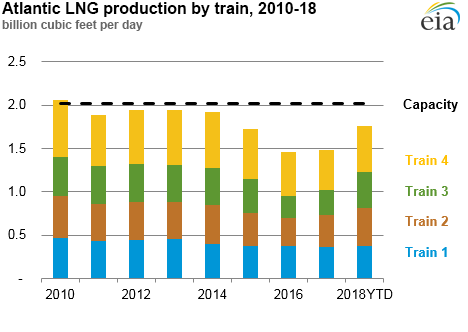 Sources: Trinidad and Tobago Ministry of Energy and Energy Industries, GIIGNL annual LNG trade reports (2011–18)
Sources: Trinidad and Tobago Ministry of Energy and Energy Industries, GIIGNL annual LNG trade reports (2011–18) Note: 2018YTD (year-to-date) includes months January–July
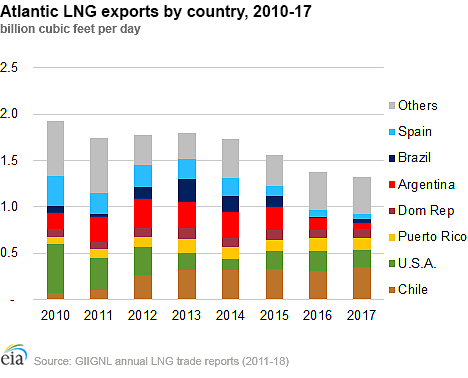
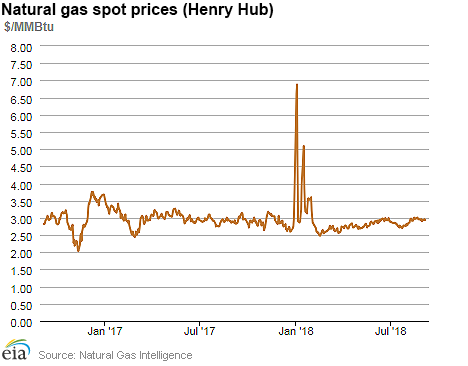
| Spot Prices ($/MMBtu) | Thu, 30-Aug |
Fri, 31-Aug |
Mon, 3-Sep |
Tue, 4-Jan |
Wed, 5-Sep |
|---|---|---|---|---|---|
| Henry Hub | 2.90 | 2.93 | Holiday | 2.96 | 2.94 |
| New York | 2.90 | 2.95 | Holiday | 3.23 | 3.06 |
| Chicago | 2.69 | 2.82 | Holiday | 2.89 | 2.87 |
| Cal. Comp. Avg,* | 2.69 | 2.64 | Holiday | 2.70 | 2.80 |
| Futures ($/MMBtu) | |||||
| October Contract | 2.874 | 2.916 | Holiday | 2.823 | 2.795 |
| November Contract | 2.901 | 2.939 | Holiday | 2.842 | 2.813 |
| *Avg. of NGI's reported prices for: Malin, PG&E Citygate, and Southern California Border Avg. | |||||
| Source: NGI's Daily Gas Price Index | |||||
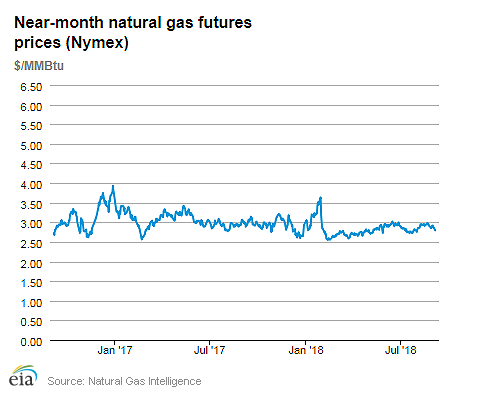
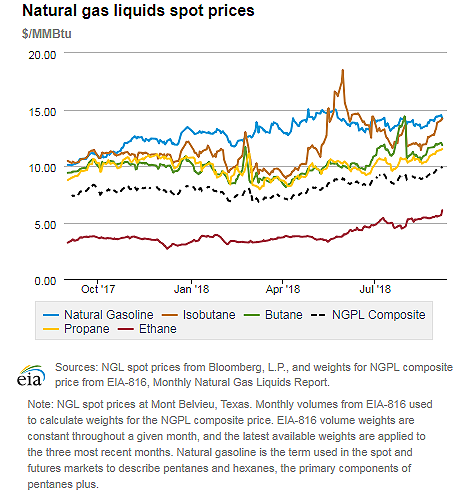
| U.S. natural gas supply - Gas Week: (8/30/18 - 9/5/18) | |||
|---|---|---|---|
Average daily values (Bcf/d): |
|||
this week |
last week |
last year |
|
| Marketed production | 93.6 |
93.3 |
80.8 |
| Dry production | 82.8 |
82.7 |
71.7 |
| Net Canada imports | 5.0 |
5.4 |
5.6 |
| LNG pipeline deliveries | 0.1 |
0.1 |
0.1 |
| Total supply | 87.9 |
88.2 |
77.4 |
|
Source: OPIS PointLogic Energy, an IHS Company | |||
| U.S. natural gas consumption - Gas Week: (8/30/18 - 9/5/18) | |||
|---|---|---|---|
Average daily values (Bcf/d): |
|||
this week |
last week |
last year |
|
| U.S. consumption | 60.9 |
62.2 |
57.7 |
| Power | 34.0 |
35.0 |
29.4 |
| Industrial | 19.7 |
19.8 |
19.9 |
| Residential/commercial | 7.2 |
7.4 |
8.4 |
| Mexico exports | 4.7 |
4.6 |
4.3 |
| Pipeline fuel use/losses | 6.7 |
6.7 |
6.3 |
| LNG pipeline receipts | 3.2 |
3.1 |
0.8 |
| Total demand | 75.5 |
76.7 |
69.1 |
|
Source: OPIS PointLogic Energy, an IHS Company | |||
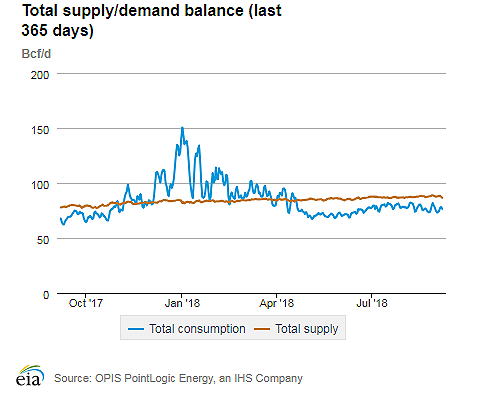
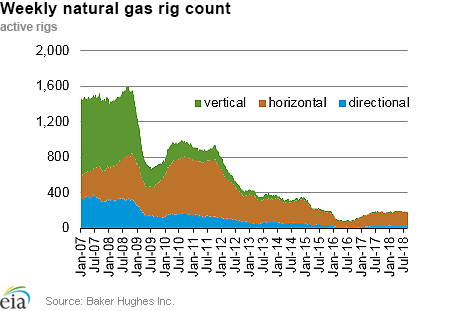
| Rigs | |||
|---|---|---|---|
Tue, August 28, 2018 |
Change from |
||
last week |
last year |
||
| Oil rigs | 862 |
0.2% |
13.6% |
| Natural gas rigs | 184 |
1.1% |
0.5% |
| Note: Excludes any miscellaneous rigs | |||
| Rig numbers by type | |||
|---|---|---|---|
Tue, August 28, 2018 |
Change from |
||
last week |
last year |
||
| Vertical | 66 |
4.8% |
-2.9% |
| Horizontal | 917 |
-0.2% |
15.5% |
| Directional | 65 |
4.8% |
-19.8% |
| Source: Baker Hughes Inc. | |||
| Working gas in underground storage | ||||
|---|---|---|---|---|
Stocks billion cubic feet (Bcf) |
||||
| Region | 2018-08-31 |
2018-08-24 |
change |
|
| East | 662 |
640 |
22 |
|
| Midwest | 699 |
667 |
32 |
|
| Mountain | 162 |
157 |
5 |
|
| Pacific | 246 |
241 |
5 |
|
| South Central | 799 |
800 |
-1 |
|
| Total | 2,568 |
2,505 |
63 |
|
| Source: Form EIA-912, "Weekly Underground Natural Gas Storage Report" | ||||
| Working gas in underground storage | |||||
|---|---|---|---|---|---|
Historical comparisons |
|||||
Year ago (8/31/17) |
5-year average (2013-2017) |
||||
| Region | Stocks (Bcf) |
% change |
Stocks (Bcf) |
% change |
|
| East | 776 |
-14.7 |
759 |
-12.8 |
|
| Midwest | 867 |
-19.4 |
847 |
-17.5 |
|
| Mountain | 205 |
-21.0 |
192 |
-15.6 |
|
| Pacific | 297 |
-17.2 |
324 |
-24.1 |
|
| South Central | 1,065 |
-25.0 |
1,036 |
-22.9 |
|
| Total | 3,211 |
-20.0 |
3,158 |
-18.7 |
|
| Source: Form EIA-912, "Weekly Underground Natural Gas Storage Report" | |||||
| Temperature – heating & cooling degree days (week ending Aug 30) | ||||||||
|---|---|---|---|---|---|---|---|---|
HDD deviation from: |
CDD deviation from: |
|||||||
| Region | HDD Current |
normal |
last year |
CDD Current |
normal |
last year |
||
| New England | 1 |
-6 |
-19 |
62 |
40 |
59 |
||
| Middle Atlantic | 1 |
-3 |
-8 |
73 |
39 |
67 |
||
| E N Central | 4 |
-4 |
-16 |
63 |
29 |
53 |
||
| W N Central | 7 |
-5 |
-3 |
61 |
15 |
30 |
||
| South Atlantic | 0 |
-1 |
-1 |
94 |
13 |
22 |
||
| E S Central | 0 |
0 |
-1 |
94 |
19 |
34 |
||
| W S Central | 0 |
0 |
0 |
137 |
26 |
49 |
||
| Mountain | 6 |
-9 |
6 |
64 |
3 |
-19 |
||
| Pacific | 3 |
-3 |
3 |
32 |
-9 |
-48 |
||
| United States | 3 |
-3 |
-5 |
75 |
19 |
26 |
||
|
Note: HDD = heating degree day; CDD = cooling degree day Source: National Oceanic and Atmospheric Administration | ||||||||
Average temperature (°F)
7-Day Mean ending Aug 30, 2018
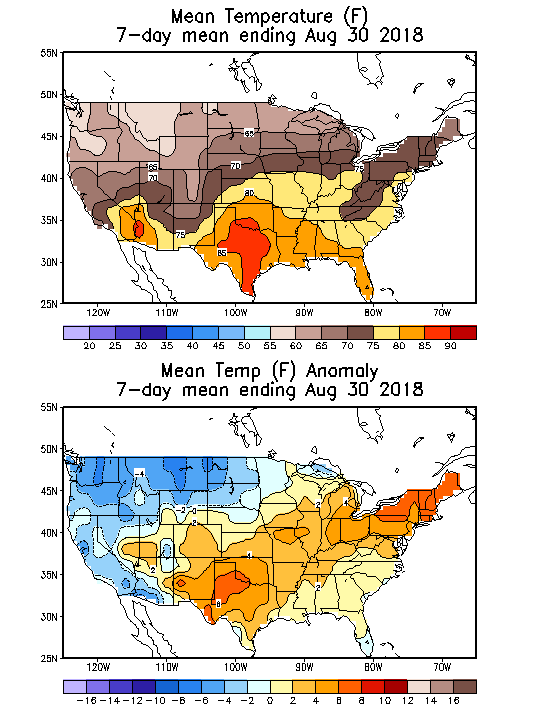
Source: NOAA National Weather Service
Deviation between average and normal (°F)
7-Day Mean ending Aug 30, 2018

Source: NOAA National Weather Service

